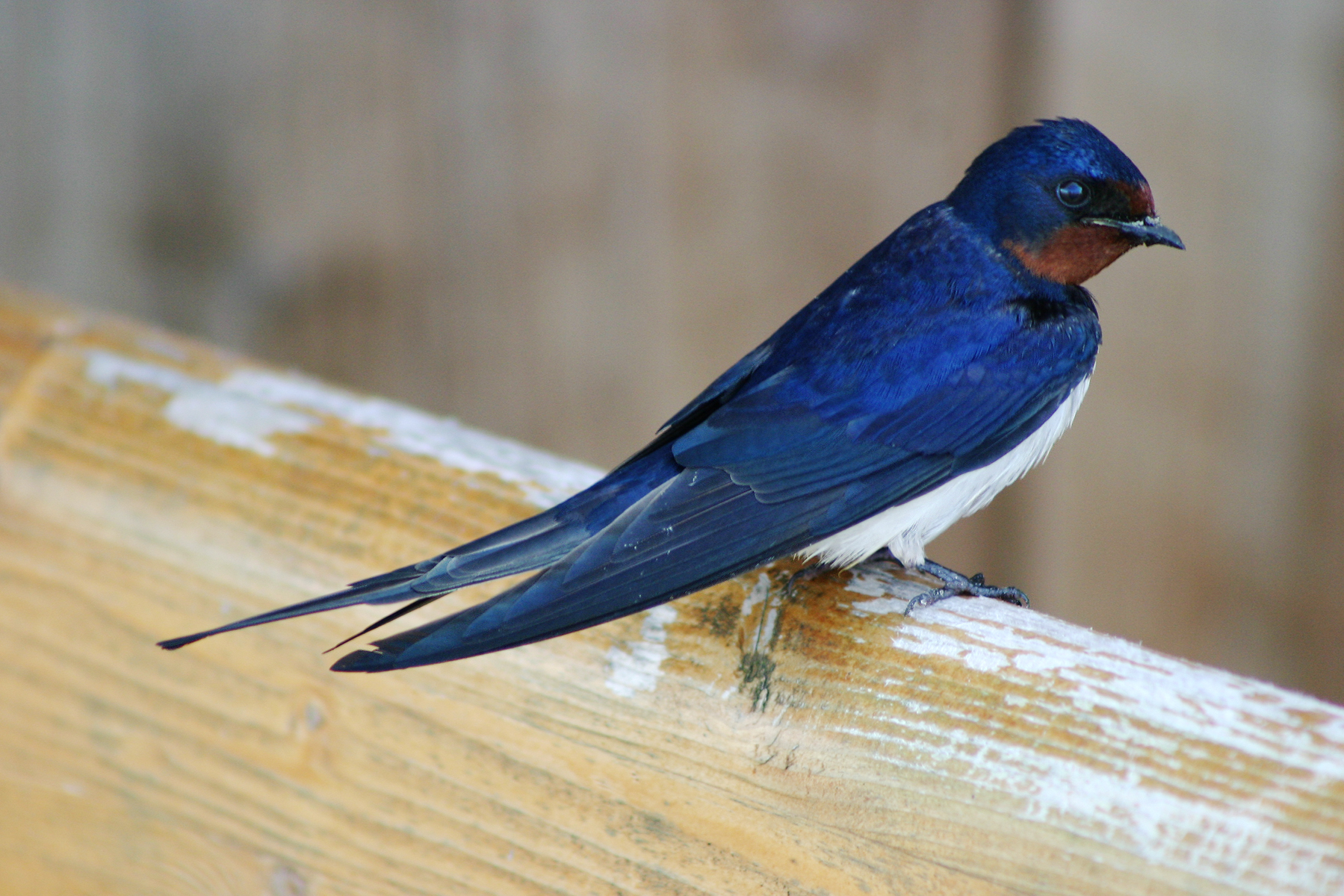Barn Swallow (Hirundo rustica) - wiki Barn Swallow
From Wikipedia, the free encyclopedia
[Photo] European subspecies of Barn swallow (Hirundo rustica). The photo is taken in the summer 2004. The place is the viewpoint at Bygholm vejle in Denmark. The swallow was very occupied with feeding the youngs, but for a minut or so it rested here, only a few meters away from me. See also the two other danish species of swallows. Date June 13, 2004. Author Malene Thyssen http://commons.wikimedia.org/wiki/User:Malene Photo Credit: Malene Thyssen, www.mtfoto.dk/malene/
The Barn Swallow (Hirundo rustica) is a small migratory passerine bird found in Europe, Asia, Africa and the Americas. It has a long, deeply forked tail and curved, pointed wings. It is often just called Swallow in Europe, although the term 'swallow' refers more widely to various members of the family Hirundinidae. The Barn Swallow makes their nests out of mud.
Subspecies
The nominate European subspecies H. r. rustica has dark blue-black upperparts, off-white underparts and a small patch of red on the throat, with a broad dark blue-black breast band separating the red throat from the off-white underparts. It breeds in Europe and western Asia, as far north as the Arctic Circle, and migrating to Africa in winter.
The North American subspecies H. r. erythrogaster differs from the European subspecies in having redder underparts and a narrower, often incomplete dark breast band. It breeds throughout North America, migrating to South America in winter.
The Middle Eastern subspecies H. r. transitiva and the resident Egyptian subspecies H. r. savignii also have orange-red underparts, but with a broad dark breast band.
The Asian subspecies H. r. gutturalis, H. r. mandschurica, H. r. saturata, and H. r. tytleri are similar to the North American subspecies, with variably darker orange underparts (pale in gutturalis, darkest, deep orange-red, in saturata) and a narrower dark breast band; they breed in eastern Asia and winter in southern Asia and northern Australia.
Behaviour
Diet
Barn Swallows are similar in habits to the other aerial insectivores, including the other related swallows and martins and the unrelated swifts (order Apodiformes). They are not particularly fast flyers (estimated at about 11 m/s), but show remarkable manoeuvrability, necessary to feed on flying insects while airborne. They are often seen flying relatively low in open or semi-open areas. It is also estimated that they beat their wings approximately 15 times each second
Nesting
Barn Swallows build neat cup-shaped nests constructed of mud collected in their beaks. The inside of the nest is lined with grasses, feathers and other soft materials. They normally nest in accessible buildings such as stables or under bridges and wharves. Before these types of sites became common, they nested on cliff faces or in caves. The female typically lays 4 or 5 eggs. Both parents build the nest and feed the young. Barn Swallows will swoop and attack intruders that venture too close their nest, often coming within inches of the threat.
The numbers in North America increased during the 20th century with the increased availability of man-made nesting sites. In recent years, there has been an ongoing gradual decline in numbers in parts of Europe and North America, due to agricultural intensification reducing the availability of insect food. However, it remains widespread and fairly common in most parts of its range.
Popular culture
The Barn Swallow has been the national bird of Estonia since 23 June 1960; to Estonians, the Barn Swallow represents free blue sky and eternal happiness. According to Estonian legend, anyone who kills a Barn Swallow will become blind, deaf and mute.
In the film Monty Python and the Holy Grail, an open and hotly debated question is the airspeed velocity of an unladen swallow, for both African and European swallows, and whether they can carry coconuts or not.
Swallows are often seen in traditional naval tattoos as a symbol of good luck or homecoming, as the birds do not travel far from land, the sight of a swallow at sea meant landfall was imminent.
Taillow & Swellow, species of Pok??mon are based on Barn Swallows.
http://en.wikipedia.org/wiki/Barn_Swallow
| The text in this page is based on the copyrighted Wikipedia article shown in above URL. It is used under the GNU Free Documentation License. You may redistribute it, verbatim or modified, providing that you comply with the terms of the GFDL. |
